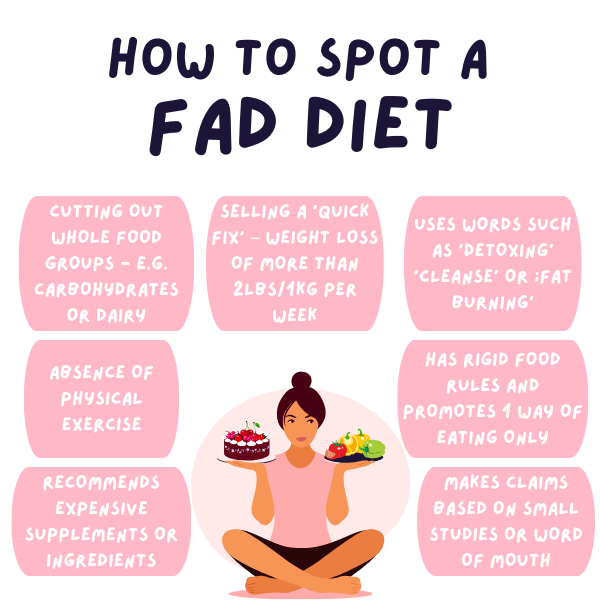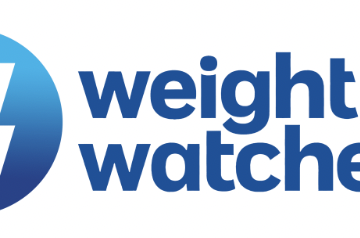Fad diets are specific diets that are done in the aim of rapid weight loss, in a short space of time. They are so called a ‘FAD’ because they are often short term and typically are unsustainable to do for a long period of time. The evidence supporting the use of FAD diets is minimal in most cases. A FAD diet often promotes excluding a number of foods, in order to achieve rapid weight loss or other health benefits. There are some aspects of FAD diets that can produce weight loss that may be sustained, though these are less common and are still often quite restrictive overall.
What is a FAD diet?
A FAD diet is a style of dieting that is designed be done in the short term. It may also be called a crash diet, and the claims are often promising fast weight loss in a short space of time. The trends of FAD diets mean that they often go in and out of fashion, and there are many FAD diets that have come out over the years. Sometimes these diets can be promoted by celebrities, and are often promoted on social media.
Here are some easy ways to spot a FAD diet;

How do FAD diets work?
FAD diets work by promising weight loss that is quick and simple. Often, these are popular because people want to try a quick fix to weight loss in the form of a FAD dit, rather than taking the extra time and effort to make slow and sustainable changes to their eating and lifestyle habits to produce long term weight loss.
The FAD diets tend to work by cutting down on the calories consumed, in a more extreme approach. You also are likely to follow strict rules for a short period of time, to ensure you lose the weight promised in a certain number of days or weeks. Much of the weight that is lost through FAD dieting isn’t often pure fat loss. Often, it is a combination of water weight loss, as well we lean muscle loss. Although the rules of the diet may be simple to follow, it can often be difficult to keep up with these all, such as cutting out certain food groups, or eating the same repetition of foods again and again. Usually, these strict rules lead to people giving up the diet after a short space of time. Once the FAD diet is stopped, it is very common to see previous dietary habits resume, which in most cases causes rapid weight re-gain, often more than a persons starting weight.
FAD diets may also claim to ‘detox’ and ‘reset’ your health – but the truth is, our bodies do not need support with detoxing. In fact, it is the role of the kidneys and liver to detoxify our body each day, by getting rid of waste products and toxins such as bacteria, alcohol, medications and by-products of digestion. They do not need support from detox diets or certain FAD diets, and the term ‘detox diet’ is a marketing term rather than an actual need for the body.
FAD food examples
There are certain types of foods, food groups or food trends that are known to be a FAD style of foods or FAD diets. For example:
- Drinking apple cider vinegar to help ‘burn fat’
- Diet pills, water pills or caffeine pills
- A regime of only consuming fruit or vegetable juices, such as ‘green juices’
- Exclusion of food groups such as removing carbohydrates or removing dairy or gluten
- Reducing calories to a number that is very low and not personalised to you
- Choosing to get your nutrition from supplements rather than whole foods
Most known FAD diets
1. Zone diet
The Zone diet focuses on eating certain specific ratios of macronutrients, to help reduce inflammation. The ratios are to follow a diet that contains 40% carbohydrates, 30% fats and 30% proteins. The carbohydrates should be low glycaemic index, to help support slow release of sugar into the blood. These are mainly from fruits & vegetables, and a small amount of whole grains. Proteins consumed should be from lean sources, and the fats should be mostly unsaturated fats, such as avocados and nuts. This sounds healthy at first glance, but taking a closer look, some foods such as bananas, carrots and peas are discouraged, due to their higher carbohydrate content. There is little to no evidence to suggest that the macronutrients on the diet are ideal for everyone, and many of the claims that are made are also not supported. Such as the Zone diet improving performance, or significantly reduces inflammation. Many factors influence these outcomes, and changes to the diet is not a quick fix for these.
2. Atkins diet
The Atkins diet is a low carbohydrate diet, in the aim to lose weight fast. Protein and fat intake is not controlled, but foods higher in carbohydrates must be avoided. Low carbohydrate diets do have a role to play in weight loss, however there are ongoing concerns due to the levels of fats promoted in the Atkins diet. Although Atkins and other low carbohydrate diets can lead to weight loss and improvements in blood sugars and HDL (good) cholesterol, it can also increase LDL (bad) cholesterol levels.
3. Paleo diet
The Paleo diet is often referred to as the ‘Stone-Age diet’ given that it looks to mimic the way humans ate during the Paleolithic era, over 2 million years ago. It includes having a range of lean meats, fish, fruits, vegetables, seeds and nuts, with an emphasis on low GI fruits & vegetables. Short term studies in small populations have shown the Paleo diet has helped reduce waist circumference, blood pressure and improve blood sugar. However, long term studies have shown no ongoing benefit. There is an exclusion of some nutritious food groups such as whole grains and dairy, which can increase risk of nutritional deficiencies such as calcium and B vitamins. There are also concerns due to the high levels of meat consumption recommended on this diet, with lower levels of fibre from exclusion of whole grains.
4. Grapefruit diet
Also known as the ‘Hollywood diet’, this diet involves eating grapefruit or drinking grapefruit juice at each meal time. The main part of the meal is focused on a high protein and low carbohydrate, and this diet promises a quick weight loss due to certain enzymes found in grapefruits which are said to be ‘fat burning’. However, there is no research to support the claims of these enzymes, and some versions of this diet promote extreme calorie restriction of up to 800 calories per day. The quick and temporary weight loss seen by this diet is often due to the calorie restriction, as well as cutting out much of the carbohydrates from the diet, rather than consumption of grapefruit itself. Although grapefruit is a great source of vitamin C and fibre, due to the lack of evidence and some of the more extreme calorie restrictions of this diet, it is not one that we would recommend to anyone!
5. Keto diet
A Keto or Ketogenic diet, is one that is very low in carbohydrates, high in fats, and moderate in proteins. The minimal carb intake (usually 10% or below of daily intake) and high fat intake (around 70% intake) leads to the metabolic state of ketosis, which is where the fat in the body is turned into ketones, to be used as an energy source. Following a Ketogenic diet can reduce blood sugar and insulin levels, as well as other potential health benefits. However, there are often initial side effects when starting the Ketogenic diet, such as diarrhoea, poor energy and nausea. These can take a while to go, although a Ketogenic diet is often not sustainable for most, due to the restrictiveness on carbohydrates and proteins, and the unpalatability of high fat consumption. Long term Ketogenic diet adherence can lead to low protein intake, which can impact muscle mass and strength, as well as risk for kidney stones and fatty liver, and certain micronutrient deficiencies.
6. Low carb diet
A Low carb diet is typically where carbohydrate intake is limited to around 25% of daily intake. This style of diet has been shown to support weight loss and improve blood sugar levels, especially in the short term. Lower carbohydrate often means restricting foods such as refined grains, starches and sweets, and sometimes even certain fruits and starchy vegetables and whole grains. Therefore, certain Low carbohydrate diets can feel restrictive and unsustainable to some, depending on lifestyle choices.
7. Gluten free diet
A gluten free diet excludes all products that contain gluten, including wheat, rye and barley. This style of diet is necessary if you have coeliac disease and need to abstain from gluten for life, however it has also been taken up as a trendy weight loss strategy. Some claim there is a link between a gluten free diet and weight loss, though this is often not backed up by evidence. One theory of possible weight loss, is that becoming gluten free allows people to eat healthier overall. For example, having to be mindful of the foods consumed can lead to more awareness of foods eaten overall, with a natural reduction in higher calorie foods. Many naturally gluten free foods include all fruits and vegetables, as well as lean proteins, which are important to include in a healthy diet – increasing consumption of these may lead to natural weight loss.
However, it is not necessary to exclude gluten from the diet without a medical need. Some gluten free substitutes available can be higher in fats and are more processed than their gluten containing alternatives, which can impact overall health. Sticking to a gluten free diet may also lead to a reduction in certain nutrients such as fibre, vitamin B12, zinc and calcium.
8. 5:2 diet
This diet is a type of restrictive eating diet, similar to other fasting style diets. The dieters are recommended to follow a ‘normal’ level of calories 5 times a week, with 2 days of the week restricted to 25% of their requirements, typically around 500-600 calories per day. This theory is that the periods of times where there are limited calories allows the body to access fat stores for energy, leading to more ‘fat burning’. Fasting can be easier to follow than traditional calorie restriction diets, and you do not have to exclude any food groups, so that can make it more manageable for some. Some research has shown the 5:2 to be as effective as calorie restriction for weight loss, and may also improve blood sugar and help manage appetite. However, due to the restrictiveness of the 2 low calorie days, it may not be realistic and sustainable for the long term. It is also important to be mindful of overall calorie intake on the 5 other days, still focusing on creating an overall calorie deficit each week, to help weight loss.
9. Dukan diet
The Dukan diet is split into 4 stages. The earlier stages are extremely restrictive and essentially contain no carbohydrates, but unlimited lean protein (known as the attack phase), with a small amount of non-starchy veggies introduced at stage 2 (cruise phase). Later phases add in some carbohydrates and fats along with the lean proteins and veggies, though overall it is still a restrictive diet. Oat bran consumption is recommended each day, most likely to support digestive health due to the restrictive nature. There is no evidence currently that this approach to weight loss is any different or achieves better results than other diets, and for many people it is likely very restrictive and hard to stick to for long lengths of time. This means that any weight loss in earlier stages is likely to be regained, if not more. It is also nutritionally unbalanced, especially to be cutting out fruits and vegetables and wholegrains for a long period of time, so it can put the person at risk of developing deficiencies.
10. Vegan diet
A Vegan diet contains no animal products – this means no meat, fish, eggs or dairy. Instead, diets contain fruits & vegetables, beans and pulses, plant based dairy alternatives and meat alternatives. Many people chose a vegan diet for ethical reasons, though some may choose this diet in the hope for weight loss. It is important to keep in mind that a vegan diet may be nutritionally imbalanced, if not well planned for.
For example, it can be harder to consume certain nutrients such as vitamin B12, iron, calcium and omega 3 fatty acids on a vegan diet, so supplementation or careful meal planning needs to be considered. If someone increases the quantity of fruits & vegetables in their diet and reduces the amount of processed animal products, this can help with weight loss – but a vegan diet isn’t designed purely for weight loss. Read more about vegan and plant based diets here.
11. South Beach diet
The South Beach Diet focuses on including foods that are a source of low-glycemic-index carbohydrates, with unsaturated fats and lean proteins. There are 3 phases of the diet, 2 for weight loss and 1 to aim for maintenance. Phase 1 is the strictest, as foods such as fruits, certain vegetables and grains are limited, as they are higher in carbohydrates. Weight loss is often fastest in this stage, though much of this loss is water weight. Phase 2 is the longest stage until a person reaches their goals, and allows the foods from phase 1, along with small amounts of certain fruits and whole grains. Although there are benefits of following a higher protein and lower carbohydrate diet, there are several restrictions of the diets, especially with the types of fats allowed. The main issue is that it may be overly restrictive with respect to the amounts and types of fats allowed, as well as limiting fruits and vegetables early on, which can influence a persons relationship with certain foods.
12. Special K diet
The Special K diet is a short term diet, designed to be done over 14 days. Where 2 meals per day are replaced with a bowl of Special K and low fat milk. Snacks of fruits and vegetables are allowed, and the third meal of the day needs to be a calorie controlled balanced meal. This diet was once promoted by the Kellogg Company, but it is no longer actively promoted. Although quick weight loss can be achieved due to the low calorie intake, it is very unsustainable and unenjoyable for most, and much of the weight lost during this time will be regained (and more) once the 14 days finish. This can lead to yo-yo dieting, which research has shown results in higher body fat mass overtime.
13. Zoe diet
The ZOE Diet Programme is a personalised nutrition programme, delivered via an app – it provides users information on what they should eat based on tests such as stool samples and blood sugar monitoring, done at home. Doing this diet can provide some interesting insights into blood sugar control and gut health, with suggestions on how to improve these for the user, though there are some drawbacks when looking at the depth of information provided and the suitability of this programme depending on the individual. Unless someone already has issues with blood sugar management (such as those with diabetes or insulin resistance), then it is not something we need to be looking into with as much detail, and it also has a colour coding system on measuring certain foods, which may not be helpful for those who struggle with their relationship with food.
14. Cabbage soup diet
This diet involves eating a homemade cabbage soup for each meal, every day, for 1 week. In addition to the soups, you are allowed 1-2 foods such as different fruits, or vegetables or milk, but this can vary. As you can see, the diet is intended to be done for just 1 week, and within that, there are claims of being able to lose up to 10lbs (4.5kg). However, much of this weight loss will be water weight lost in this period of time. And this is in no way a sustainable diet, given that the main food is just cabbage in the soup, which is not enough to support our bodies nutritional requirements for proteins, carbohydrates and healthy fats, as well as plenty other vitamins and minerals which will be lacking on this diet.
It is very likely that significant weight loss will occur in this week, however, due the significant reduction in calories, this FAD diet can also negatively impact metabolism, reducing the number of calories the body burns per day. This in turn can lead to long lasting damaging effects of doing these FAD diets. The diet is not recommended to be done for more than 1 week at a time, as it is very restrictive. Therefore, a weeks diet will not lead to any significant and sustainable weight loss in the long term.
What to consider before starting a FAD diet?
If you are looking for quick weight loss, you may be considering a FAD diet. Although there are plenty of diets to choose from, it is important to consider the following before making changes:
- What do you want to achieve? What are your goals, and what is the motivation behind making the changes? Are you wanting to lose weight for the right reasons?
- Will this be a long or short term fix? Many diets are very restrictive in nature, which means they are often only a temporary solution, and any weight lost will likely be re-gained. Do you want this to be a temporary change, or are you looking for more long term and sustained weight loss?
- Planning for the diet. Think ahead to the changes that you will have to make, what food you will need to include and what to avoid, and how long for. Is this food you enjoy, or do you think you may feel too restricted? Are you still able to maintain your regular routine of exercise with the changes in your diet?
- How will the changes effect those around you? If you are part of a family, will you need to make different meals for others, or will they also join in with your diet? How will the changes influence others who may not want to focus on weight loss, and will the changes be sustainable to keep up with at home?
- Think about your mental health. Quick changes can give us a boost, but if you are finding that you then give up once it becomes too difficult, that can leave you feeling upset and like you have failed. Will it lead to yo-yo dieting, where you are on and off these short term fixes for years, and is that something you want to keep doing, or would you like to make long term changes that are sustainable?
- Keep in mind any health or medical conditions you have. You do not want to put your health at any risk, so speak to a medical professional or a dietitian, before making any changes to your diet.
What are the dangers of FAD diets?
Although FAD diets will lead to initial weight loss, there are drawbacks and dangers to keep in mind, such as:
- Most FAD diets are unsustainable – there is often a focus on restricting specific types of foods, such as fats or carbs, but it is all temporary. Once the person finishes the diet, the weight that was lost will just be put back on.
- Can be harmful for mental and physical health. This is because certain food groups are excluded or heavily restricted on diets, which can make us fear certain foods in the long term, influencing our relationship with food even when the diet stops. FAD diets can lead to initial weight loss, but often this is mainly fluid and muscle loss, rather than fat mass. Because of this, weight loss is not sustained, and it can be mentally challenging to see no long term change, even with the effort being put in. Diets can be mentally fatiguing as well as causing guilt and anxiety over certain food choices. when a person is trying out FAD diet after FAD diet, these diets often fail to work and weight regain is cycled with weight loss, which creates a cycle of dieting known as yo-yo dieting. This itself damages metabolism and further impacts mental and physical wellbeing. Therefore, FAD diets can be dangerous.
- Impacting metabolism – severely cutting back on calories will also cause the metabolism to reduce, which is the amount of energy (calories) the body burns each day. As your body will feel deprived with lower calorie intake, it is normal for the body to slow down the metabolism, to prevent any energy loss that isn’t necessary. The loss in muscle can also reduce metabolism.
- Are not balanced – many diets are focused around cutting certain foods or food groups, meaning that there will be specific nutrients that are being missed out on, which can increase risk of nutritional deficiency, which can impact our health in the long term.
- Are expensive – often, the FAD diets will include taking supplements or shakes, or enrolling in a plan or programme. These will generally come at a cost, which is probably higher than just focusing on a balanced and varied diet of whole foods.
What should you avoid when looking at FAD diets?
You should avoid any FAD diet that:
- Claims to lead to fast and easy weight loss
- Requires the elimination or severe restriction of certain food groups, such as carbohydrates or fats
-
Labels certain foods as ‘good’ or ‘bad’ foods
-
Calls to skip certain meals
- Requires you to purchase specific supplements, especially anything that will ‘boost’ metabolism or ‘burn’ fat, or aid in weight loss
- Glorifies specific foods, such as shakes or soups or grapefruit
- Does not require any change to your behaviour or mindset around food, in terms of looking at hunger levels and reasons for eating
Many of the diets described above will have at least one of these aspects, making them FAD diets which we would recommend avoiding.
What FAD diets don’t work and why?
The appeal of FAD diets is that they are a quick fix in the short term. Yes they work by reducing weight, but often the weight loss is fluid or lean muscle. Although the weight loss can be fairly quick and large, these restrictions with FAD diets mean that people will likely be unable to maintain the restrictions, leading to the failure of the diet. If the diet in question leaves you feeling hungry, more tired and low in energy, perhaps thinking of food a lot more and having stronger cravings, this is not a diet that will work in the long term. It can get to a point where someone deprives themselves of certain foods for so long, they will end up giving up and binge eating on those foods, which can then lead to weight re-gain.
FAD diets often do not work as they can lead to a negative relationship with food choices, leaving a person feeling guilty or stressed about certain foods if they do not fit into their FAD diet requirements. This in turn can lead to binges, if a person makes a ‘mistake’ or ‘cheats’ on their diet. If a FAD diet is followed for a while with certain foods or groups of foods being excluded, there is a risk of developing nutritional deficiencies, which can then impact bone and muscle growth, lead to hormonal and bowel changes, and can lead to long term metabolism damage.
For example, the 5:2 diet may be very difficult for many people to follow on the restricted calorie days, especially if calories have to be kept as low as 500 calories per day – many people would struggle with fatigue, extreme hunger and cravings. On the non fasting days, this can increase risk of over eating and binging on the foods they had to avoid on the fasting days. This means overall, a person may end up being in surplus calories, which will not support weight loss.
Another example is the Zoe diet. With this diet, blood sugar levels are monitored, in order to see a reaction in the blood sugar spike and drop. For the majority of people, having rises and falls in blood sugar is healthy and a very normal part of the response to eating. But seeing a rise and fall in blood sugar in response to something such as a banana or a chickpea curry (which is very normal!), can lead to fear and avoidance of these foods, which can then overly restrict the diet without an actual need, impacting a persons relationship with certain foods.
Is a FAD diet temporary?
In many cases, FAD diets are unsustainable, and a person cannot keep up with the FAD diet rules and requirements. If a person does reach their weight loss goal whilst on a FAD diet, it is likely that a person will stop the FAD diet and resume more regular eating habits. This will lead to weight regain, and often will cause more weight to be gained than their original starting weight. The fact is most FAD diets are short term solutions but not designed to be continued for the long term, as they are too restrictive, difficult to maintain, don’t fit into realistic lifestyles and also can be inconvenient to keep up with for the long term.
What can you do to make these FAD diets more effective?
It is important to try to view dietary changes as long term and sustainable changes, rather than drastic quick fixes. Instead, focus on what you can add IN to the diet, rather than cutting OUT. For example, think about adding a larger variety of fruits and vegetables into meals, and also including more whole foods, rather than relying on shakes or powders or supplements. As well as looking at what we eat, it is important to consider how and why we eat. Choose to eat when you are hungry and be able to recognise when you are eating to meet the hunger, but are not full. This way, you eat until content, but are not eating more than the body needs.
Do not eliminate food groups, but rather work on being moderate with certain foods that may be higher in fats or sugars, or are more processed. Include these foods in small amounts if you do like, and take the time to savour and enjoy them, to remove any guilt attached. Think also about adding in regular activity to keep you moving, which can also greatly improve how we feel overall.
By making these changes, you will likely be able to stick to the diets for longer – even if the weight loss is slower, it is more realistic to be able to sustain for the long term.
What FAD diets do work?
There are some FAD diets that may help, such as the lower carbohydrate diet or the ZOE diet.
For example, many people may prefer a lower carbohydrate approach to eating, where they have one carb free meal per day and instead focusing on more vegetables. This doesn’t mean they are excluding any food groups completely, but are working on creating a calorie deficit by replacing the small amount of carbs with vegetables instead, which are lower in calories and very satiating. However, there are certain populations of people who may need a higher carbohydrate intake, such as those who are very physically active.
The ZOE diet can be a helpful way to support people to make better food choices each day, by showing examples of foods that are generally higher in fibres and proteins, which can support weight loss. The blood sugar monitoring aspect can be useful for those with type 2 diabetes or blood sugar related conditions such as insulin resistance or PCOS. Though this may not be appropriate or necessary for all.
The main diet that works is one that you can stick to, and still enjoy. Find a way of eating that you can maintain and that helps you to lose weight in the long term.
FAD diets vs. healthy eating
| FAD diets | Healthy Eating |
| Excludes certain food groups or restriction to a certain level of calories | Practices including all food groups, with variety and moderation without counting calories |
| Claims that certain foods are ‘bad’ and should be avoided | No foods are ‘bad’ but working on balance and overall quality of diet is key |
| Focuses just on the number on the scales | Looks at health overall, such as energy levels, sleep quality, relationship with food, risk of chronic disease etc |
| Has an end date or is temporary | No end goal, this is for life |
| Promises a quick fix or quick weight loss | Is long term and changes will not come in a few short weeks or months |
| Making big drastic changes | Sustainable lifestyle changes which are slow |
| Does not talk about exercise | Encourages regular physical activity in a way that you enjoy |
| Weight loss is temporary | Any weight loss is for life |
| Encourages certain supplements or medications | Most nutrients can be obtained through a balanced and varied diet without reliance on a range of supplements |
| Removes many of your favourite foods | No exclusion of any foods you enjoy, but learning to enjoy them mindfully |
Tips for healthy weight loss
If you are looking to make some gradual and sustainable changes to your diet and lifestyle, here are our top tips to help you along the way:
Increase your servings of fruits and/or vegetables across the day. Aim to work up to including around 2 handfuls of vegetables/salad at meal times where you can, and incorporate fruits or vegetables into snacks.
Choose a good quality lean protein at each meal time. This can help keep you full and satisfied for longer, meaning you are less likely to feel hungry in between meals. Good examples include chicken or turkey, fish, as well as vegetarian sources such as beans and lentils and tofu.
Go for whole grain options, for your carbohydrates. Carbs are not the enemy! But including a serving of these at meal times with more vegetables and enough lean protein is important to work on a balanced meal. We recommend whole grains, as they contain more fibre to keep you fuller for longer, as well as fibre having multiple benefits for our overall health. Examples include brown rice, wholemeal pasta, whole grain bread, grains such as quinoa or buckwheat etc.
If you find that you do get hungry between meals, choose a snack that provides both protein and fibre. This combination is ideal to keep you satisfied for longer. For example, a piece of fruit and small handful of nuts, or a few whole grain crackers topped with boiled eggs.
Keep hydrated with water throughout the day. In this, herbal teas and a small amount of regular tea and coffee also contributes to hydration, but water is important to help us feel better, supporting the removal of waste from our body and also helping to provide nutrition into our cells. Keep a water bottle with you to help you monitor your water intake.
Think about why you are eating and look at your hunger levels. Often we eat out of habit or routine, but it’s important to check in with yourself to see how you feel. Are you hungry, and how hungry are you? When you are eating, do you notice yourself feeling satisfied before the meal has finished? That can help you understand better what portion sizes are right for you in that moment.
Reduce intake of processed foods, being aware of how to be aware of what processed foods are, and looking for healthier alternatives. For example, many cereals can be heavily processed and high in sugar. Instead, choose a wholegrain cereal with minimal to no added sugars, and choose to sweeten the cereal with fruits.
Improving exercise and daily movement. This doesn’t have to mean sweaty and high intense gym classes, but move your body more often in a way that you enjoy. For example, a dance class or cycling with friends around the local park, as well as doing a home based strength workout. Regular exercise not only helps with our physical health but also plays an important role in our mental health and wellbeing.
Focus on good quality sleep. Research has shown that sleep deprivation can lead to over eating. If you have long term problems with sleep, we recommend reaching out to a sleep expert for support.
Managing stress better, as this can also play a key role in how our body gains or loses weight. Certain hormones can make it harder to lose weight if we are chronically stressed, so working on stress management techniques is key. This can include increasing exercise, trying meditation or looking at cognitive behavioural therapy (CBT).
Be patient, as these changes are slower and the weight loss will take time. It’s not a quick fix for the short term, these are lifestyle habits you are working on changing. Focus on the journey and celebrate all the small wins along the way.
Find your balance of losing weight healthily by working with a private dietitian.







